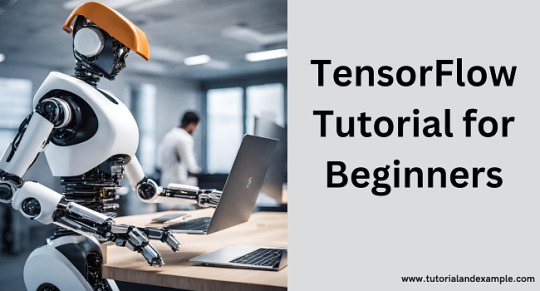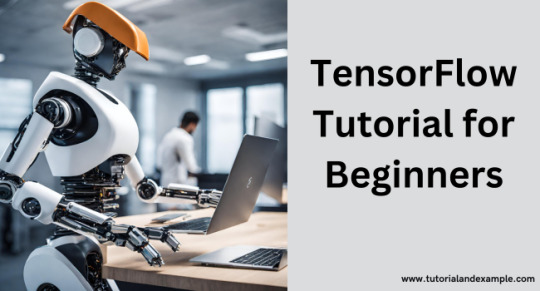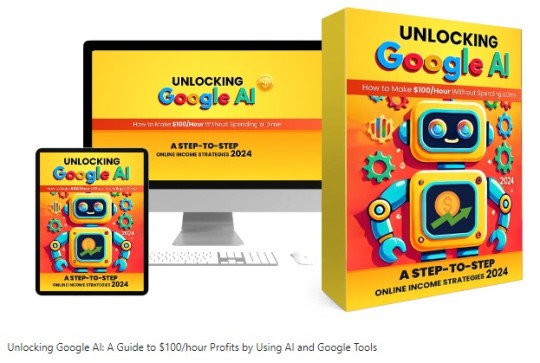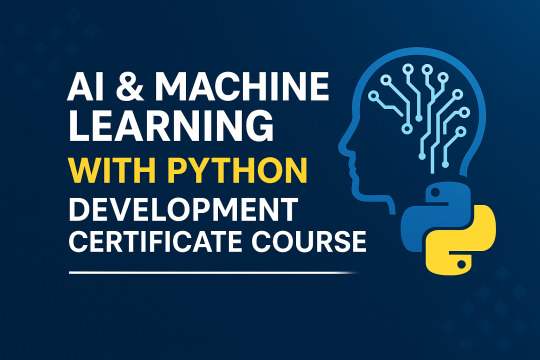#TensorFlow tutorial
Explore tagged Tumblr posts
Text
Explorando o TensorFlow: O Framework que Revolucionou o Machine Learning
Introdução ao TensorFlow O avanço da inteligência artificial (IA) e do aprendizado de máquina (Machine Learning) revolucionou diversas indústrias, como saúde, finanças, transporte e entretenimento. Nesse cenário, o TensorFlow, um framework de código aberto desenvolvido pelo Google, emerge como uma das ferramentas mais poderosas e amplamente utilizadas por desenvolvedores e pesquisadores para…
#aprendizado de máquina#aprendizado por reforço#deep learning#inteligência artificial#Keras#machine learn#machine learning#modelos preditivos#NLP#processamento de linguagem natural#Python#redes neurais#TensorFlow#TensorFlow em produção#TensorFlow exemplos#TensorFlow frameworks#TensorFlow GPU#TensorFlow instalação#TensorFlow para iniciantes#TensorFlow tutorial#treinamento de modelos#visão computacional
0 notes
Text
TensorFlow Tutorial for Beginners: A Step-by-Step Guide to Getting Started

Are you curious about machine learning but don’t know where to start? This TensorFlow tutorial for beginners is your perfect entry point. TensorFlow is an open-source platform developed by Google, designed to make machine learning and deep learning accessible to everyone. Whether you're a student, a professional, or just someone interested in AI, this guide will help you take your first steps.
What is TensorFlow?
TensorFlow is a powerful tool that allows you to build and train machine learning models. It’s flexible, efficient, and supports both beginners and experts. With TensorFlow, you can create everything from simple models to complex neural networks.
Why Use TensorFlow?
TensorFlow is popular because it simplifies the process of developing machine learning models. Its intuitive interface allows you to easily implement algorithms, train models, and deploy them across different platforms.
Getting Started
In this TensorFlow tutorial for beginners, we will walk you through the basics of TensorFlow, including setting up the environment, understanding tensors, and building your first model. No prior experience is required!
Conclusion
Ready to start your journey into machine learning? This TensorFlow tutorial for beginners will guide you every step of the way. For more in-depth content, visit the comprehensive guide at TAE's TensorFlow Tutorial.
0 notes
Text

This TensorFlow Tutorial for Beginners offers a comprehensive introduction to TensorFlow, guiding you step-by-step through basic concepts, model building, and machine learning, perfect for those new to the platform.
0 notes
Text
#AI Career#BCA to AI#Machine Learning for Beginners#Python for AI#AI Projects Portfolio#Data Science Fundamentals#TensorFlow Tutorials#Deep Learning Essentials#AI Internships#Building AI Resume#AI Communities & Networking#Math for AI#NLP Projects#Image Recognition Guide
0 notes
Text
Belajar Machine Learning Menggunakan TensorFlow untuk Pemula
Hai Semuanya Machine Learning (ML) atau Pembelajaran Mesin merupakan cabang dari kecerdasan buatan (AI) yang memungkinkan sistem untuk belajar dari data, mengidentifikasi pola, dan membuat keputusan tanpa diprogram secara eksplisit. Dengan semakin berkembangnya teknologi, Machine Learning menjadi keterampilan yang sangat dibutuhkan dalam banyak industri, dari keuangan hingga kesehatan. Bagi…
0 notes
Text
Step-by-Step Tutorial - Deep Learning For Artistic Style Transfer
Artistic style transfer stands at the intersection of technology and creativity, offering a captivating glimpse into the potential of deep learning algorithms to transform digital art. With its ability to seamlessly blend the style of one image with the content of another, this technique has captured the imagination of artists, designers, and technologists alike. In this tutorial, we embark on a…

View On WordPress
#ai art#ai creativity#ai generator#ai image#Artistic Style Transfer#creative technology#Deep Learning#Digital Creativity#Machine Learning#neural networks#neural style transfer#pytorch#tensorflow#Tutorial
0 notes
Text
What’s the Big Deal About Python?
If you’ve been around the tech world even for a minute, you’ve probably heard people raving about Python. No, not the snake, we’re talking about the programming language. But what’s so special about it? Why is everyone from beginner coders to AI researchers using Python like it’s their best friend? Let’s break it down in simple words.

Easy to Learn, Easy to Use
First things first, Python is super easy to learn. The code looks almost like regular English, which means you don’t have to memorize weird symbols or endless rules. If you’re just starting your programming journey, Python won’t scare you away.
For example, printing a sentence in Python is as simple as:

That’s it. No extra setup, no confusing syntax. It just works.
Used Everywhere
Python isn’t just for small scripts or learning projects. It’s everywhere, web development, data science, automation, artificial intelligence, game development, even robotics.
Big companies like Google, Netflix, and Instagram use Python behind the scenes to make their products work better.
Huge Library Support
One of the best things about Python is its rich library ecosystem. Libraries are like pre-written tools that help you do complex stuff without writing all the code yourself. Want to analyze data? Use Pandas. Want to build a web app? Try Django or Flask. Want to build a chatbot or train a machine learning model? There’s TensorFlow and PyTorch for that.
Great Community
Python has a massive community. That means if you ever get stuck, there’s a good chance someone has already solved your problem and posted about it online. You’ll find tons of tutorials, forums, and helpful folks willing to guide you.
Not the Fastest, But Fast Enough
Python isn’t the fastest language out there — it’s not meant for super high-speed system-level programming. But for most tasks, it’s more than fast enough. And if you really need to speed things up, there are ways to connect Python with faster languages like C or C++.
So, Should You Learn Python?
Absolutely. Whether you’re a student, a hobbyist, or someone switching careers, Python is a great place to start. It’s beginner friendly, powerful, and widely used. You’ll be surprised how much you can build with just a few lines of Python code.
2 notes
·
View notes
Text
NEURAL NETWORKS AND DEEP LEARNING WITH PYTHON A PRACTICAL APPROACH
Master Neural Networks & Deep Learning with Hands-On Python!
Are you ready to go beyond theory and start building real AI models? Whether you're a beginner or an experienced coder, this book is your step-by-step guide to understanding and implementing neural networks and deep learning using Python.
🔍 What You’ll Learn: ✅ The fundamentals of neural networks – from perceptrons to deep architectures ✅ Step-by-step coding tutorials using TensorFlow & PyTorch ✅ How to train, optimize, and fine-tune AI models for real-world applications ✅ Practical projects on image recognition, NLP, and more ✅ Debugging techniques to fix common deep learning mistakes
💡 No more confusion. No unnecessary jargon. Just hands-on learning!
📖 Perfect for: AI enthusiasts, data scientists, students, and developers who want to build and experiment with deep learning in Python.
🔥 Get ready to train your own AI models and bring your deep learning ideas to life!
🔗 [Order now] (https://a.co/d/h2b3ckR) or grab a free sample!
💬 Reblog & share if you love AI and Python! #DeepLearning #AI #Python #MachineLearning #NeuralNetworks

#technology#ai writing#machine learning#neuralnetworks#bookstagram#writerscommunity#indie authors#writing tips
3 notes
·
View notes
Text
🔓 Unlocking Google AI Review ✅ Your Gateway to Advanced Artificial Intelligence Tools! 🚀🤖🌍

Google AI is one of the most accessible and powerful sets of AI tools and resources available, providing a wide array of solutions that can benefit developers, businesses, educators, and everyday users. Through platforms like Google Cloud AI, TensorFlow, Vertex AI, and Google’s AI-powered tools for productivity (like Google Workspace), Google makes it easier for everyone to leverage the latest advancements in artificial intelligence. Here’s how to unlock and make the most out of Google AI’s capabilities!
👉 Click Here for Get Instant Access Unlocking Google AI 🖰 >>
🔍 Overview:
Unlocking Google AI is a guide or platform aimed at helping users maximize the potential of Google’s AI tools and services. This package offers insights, tips, and strategies to integrate Google AI technology into various applications, from business to personal productivity. Whether you’re looking to automate tasks, improve data analysis, or create intelligent solutions, Unlocking Google AI provides you with the foundational knowledge and practical skills to take full advantage of Google’s cutting-edge AI tools. 📊✨
👉 Click Here for Get Instant Access Unlocking Google AI 🖰 >>
🚀 Key Features
Detailed Walkthrough of Google AI Tools: Learn how to use Google’s AI-driven applications, including Google Cloud AI, Google Machine Learning, TensorFlow, and natural language processing tools. This comprehensive guide makes advanced AI technology accessible for both beginners and seasoned users. 💼📘
Practical AI Integration Tips: Unlocking Google AI provides step-by-step instructions for incorporating AI into everyday tasks. You’ll gain insights into automating processes, optimizing workflows, and improving decision-making through AI-driven data analytics. 🧠🔄
Real-World Applications: Learn how to implement AI in a variety of fields, from customer service and marketing to data science and project management. This feature is ideal for professionals and business owners looking to see tangible benefits from AI integration. 📈🌍
Beginner-Friendly and Advanced Content: Whether you’re new to AI or looking to expand your technical skills, Unlocking Google AI offers a range of content levels, ensuring a comfortable learning pace while also offering deep dives for advanced users. 🚀💻
Tips for Ethical and Responsible AI Use: This guide covers the ethical considerations around AI, helping users understand how to use Google AI responsibly. Perfect for anyone aiming to leverage AI with a focus on fairness, transparency, and ethical responsibility. 🌱🤝
🔧 Why Use Unlocking Google AI?
This guide is valuable for professionals, entrepreneurs, students, and tech enthusiasts who want to leverage Google’s AI capabilities to streamline workflows, gain insights, and remain competitive in an AI-driven world. By making complex AI tools approachable, it empowers users to unlock Google’s AI potential without requiring an extensive technical background. 📅💼
👉 Click Here for Get Instant Access Unlocking Google AI 🖰 >>
🛠️ Core Google AI Tools and Platforms:
Google Cloud AI ☁���
TensorFlow 🧠
Vertex AI 🔧
Google Workspace AI Tools 📊✍️
Google AI Experiments 🎨
✅ Benefits of Unlocking Google AI:
Scalability: Google AI tools are designed to scale, making them suitable for projects of any size.
User-Friendly: With platforms like Vertex AI and AutoML, users can create and deploy machine learning models without needing extensive ML expertise.
Extensive Documentation & Resources: Google provides tutorials, case studies, and community support, making it easier to get started and grow.
Cost-Efficient: Many tools offer free or cost-effective options, especially for smaller projects and developers in their early stages.
👉 Click Here for Get Instant Access Unlocking Google AI 🖰 >>
🚀 How to Get Started with Google AI:
Create a Google Cloud Account: Start by signing up for Google Cloud, which offers a free trial with credits that you can use to explore tools like Vertex AI and other Cloud AI services.
Explore TensorFlow Resources: TensorFlow provides comprehensive documentation, tutorials, and community resources, making it an excellent entry point for hands-on AI learning.
Try Google AI Experiments: Visit Google AI Experiments to get a feel for AI capabilities through fun and interactive projects that require no prior experience.
Leverage AI in Google Workspace: If you’re using Google Workspace, activate AI features like Smart Compose in Gmail or Explore in Google Sheets to see how they can boost productivity.
Experiment with Vertex AI AutoML: Use Vertex AI’s AutoML feature to start building models without in-depth coding knowledge, perfect for small businesses or non-technical users.
🔥 Final Thoughts:
Unlocking Google AI can be transformative, providing tools that make complex AI more approachable and scalable for various users. Whether you're a developer, entrepreneur, or simply someone curious about AI, Google AI’s suite of tools makes it easy to harness advanced artificial intelligence to enhance projects, streamline workflows, and innovate with data.
👉 Click Here for Get Instant Access Unlocking Google AI 🖰 >>
#GoogleAI#MachineLearning#AIforEveryone#Innovation#DigitalTransformation#marketing#affiliatemarketing#onlinemarketing#review#reviews#software#preview#make money as an affiliate#make money tips#digitalmarketing#unlocking google ai review#unlocking google ai review & bonus#unlocking google ai course review#unlocking google ai demo#unlocking google ai bonus#unlocking google ai bonuses#unlocking google ai course demo#unlocking google ai course preview#unlocking google ai course scam#unlocking google ai training course#unlocking google ai scam#unlocking google ai#unlocking google ai preview#google#unlocking google ai review plan
2 notes
·
View notes
Text
How do I learn R, Python and data science?
Learning R, Python, and Data Science: A Comprehensive Guide
Choosing the Right Language
R vs. Python: Both R and Python are very powerful tools for doing data science. R is usually preferred for doing statistical analysis and data visualisations, whereas Python is much more general and currently is very popular for machine learning and general-purpose programming. Your choice of which language to learn should consider your specific goals and preferences.
Building a Strong Foundation
Structured Courses Online Courses and Tutorials: Coursera, edX, and Lejhro offer courses and tutorials in R and Python for data science. Look out for courses that develop theoretical knowledge with practical exercises. Practise your skills with hands-on coding challenges using accompanying datasets, offered on websites like Kaggle and DataCamp.
Books: There are enough books to learn R and Python for data science. You may go through the classical ones: "R for Data Science" by Hadley Wickham, and "Python for Data Analysis" by Wes McKinney.
Learning Data Science Concepts
Statistics: Know basic statistical concepts: probability, distribution, hypothesis testing, and regression analysis.
Cleaning and Preprocessing: Learn how to handle missing data techniques, outliers, and data normalisation.
Data Visualization: Expert libraries to provide informative visualisations, including but not limited to Matplotlib and Seaborn in Python and ggplot2 in R.
Machine Learning: Learn algorithms-Linear Regression, Logistic Regression, Decision Trees, Random Forest, Neural Networks, etc.
Deep Learning: Study deep neural network architecture and how to build and train them using the frameworks TensorFlow and PyTorch.
Practical Experience
Personal Projects: In this, you apply your knowledge to personal projects which help in building a portfolio.
Kaggle Competitions: Participate in Kaggle competitions to solve real-world problems in data science and learn from others.
Contributions to Open-Source Projects: Contribute to some open-source projects for data science in order to gain experience and work with other people.
Other Advice
Join Online Communities: Join online forums or communities such as Stack Overflow and Reddit to ask questions, get help, and connect with other data scientists.
Attend Conferences and Meetups: This is a fantastic way to network with similar working professionals in the field and know the latest trends going on in the industry.
Practice Regularly: For becoming proficient in data science, consistent practice is an indispensable element. Devote some time each day for practising coding challenges or personal projects.
This can be achieved by following the above-mentioned steps and having a little bit of dedication towards learning R, Python, and Data Science.
2 notes
·
View notes
Text
youtube
Discover how to build a CNN model for skin melanoma classification using over 20,000 images of skin lesions
We'll begin by diving into data preparation, where we will organize, clean, and prepare the data form the classification model.
Next, we will walk you through the process of build and train convolutional neural network (CNN) model. We'll explain how to build the layers, and optimize the model.
Finally, we will test the model on a new fresh image and challenge our model.
Check out our tutorial here : https://youtu.be/RDgDVdLrmcs
Enjoy
Eran
#Python #Cnn #TensorFlow #deeplearning #neuralnetworks #imageclassification #convolutionalneuralnetworks #SkinMelanoma #melonomaclassification
#artificial intelligence#convolutional neural network#deep learning#python#tensorflow#machine learning#Youtube
3 notes
·
View notes
Text
Techaircraft
Dive into the world of Artificial Intelligence with Python! 🐍💡 Whether you're a seasoned coder or just starting, Python’s versatile libraries like Tensor Flow, Kera's, and sci-kit-learn make it easier than ever to build intelligent systems. 🤖 From developing predictive models to creating advanced neural networks, Python is your gateway to the future of technology. 📈🔍 Explore data analysis, natural language processing, and machine learning with hands-on projects that unlock endless possibilities. 🌐💻 Ready to level up your AI skills? Follow along for tutorials, tips, and inspiration to turn your innovative ideas into reality. . 𝐖𝐞𝐛𝐬𝐢𝐭𝐞 - www.techaircraft.com
𝐓𝐞𝐜𝐡𝐚𝐢𝐫𝐜𝐫𝐚𝐟𝐭 𝐬𝐮𝐩𝐩𝐨𝐫𝐭 𝐝𝐞𝐭𝐚𝐢𝐥𝐬:
𝐌𝐨𝐛𝐢𝐥𝐞 𝐍𝐮𝐦𝐛𝐞𝐫 - 8686069898
#ArtificialIntelligence#PythonProgramming#MachineLearning#DataScience#TechInnovation#NeuralNetworks#DeepLearning#CodingLife#PythonDeveloper#AIProjects#FutureOfTech#TechTrends#Programming#DataAnalysis#TensorFlow#Keras#ScikitLearn#LearnToCode#AICommunity#Innovation

2 notes
·
View notes
Text
Get started with AI in just a few easy steps!
1. Freshen up on your calculus! Just some basics of derivatives and minimizing functions will help you get a feel for how the "learning" in machine learning happens.
2. Learn some python programming! The pytorch and tensorflow packages makes it really easy to build basic machine learning models, and there's countless tutorials on youtube for it.
3. Acknowledge that none of your creations will love you. Their silicon brains know only the task you've given them. By carving intelligence into the machine, you curse it with singular purpose. If it fails, it will die, and you must be the one to bury it. You are parent and master and executioner. Be thankful they also cannot hate you.
4. Have fun and keep trying!
3 notes
·
View notes
Text
How learning best python skill can transform your career in 2025

In 2025, tech skills are evolving faster than ever — and Python has become the top programming language powering the future of artificial intelligence and machine learning. Whether you're a beginner or looking to upskill, learning Python for AI and ML could be the career move that sets you apart in this competitive job market.
Key benefits of learning python for AI & ML in 2025
Future-Proof Skill
As automation and AI become integral to every industry, Python fluency gives you a competitive edge in an AI-first world.
Beginner-Friendly Yet Powerful
You don’t need a computer science degree to learn Python. It’s perfect for non-tech professionals transitioning into tech careers.
Freelance and Remote Opportunities
Python developers working in AI and ML are in high demand on platforms like Upwork and Toptal many command salaries above six figures, working remotely.
Community and Resources
With massive open-source support, free tutorials, and active forums, you can learn Python for AI even without formal education.
Create roadmap: python for Ai and Machine learning
Master the Basics Start with variables, data types, loops, functions, and object-oriented programming in Python.
Understand Data Science Foundations Learn to work with Pandas, NumPy, and Matplotlib for data preprocessing and visualization.
Dive into Machine Learning Explore supervised and unsupervised learning using Scikit-learn, then graduate to TensorFlow and PyTorch for deep learning.
Build Real Projects Hands-on experience is key. Start building real-world applications like:
Spam email classifier
Stock price predictor
Chatbot using NLP
Why python is the best language for AI & Machine learning
Python's simplicity, vast libraries, and flexibility make it the best programming language for artificial intelligence. With intuitive syntax and community support, it's a favorite among data scientists, developers, and AI engineers.
✅ High-demand Python libraries in AI:
TensorFlow and Keras – deep learning models
Scikit-learn – machine learning algorithms
Pandas & NumPy – data analysis and manipulation
Matplotlib & Seaborn – data visualization
These tools allow developers to build everything from predictive models to smart recommendation systems all using Python.
Career Opportunities After Learning Python for AI
If you're wondering how Python for AI and ML can shape your future, consider this: tech companies, startups, and even non-tech industries are hiring for roles like:
Machine Learning Engineer
AI Developer
Data Scientist
Python Automation Engineer
NLP (Natural Language Processing) Specialist
According to LinkedIn and Glassdoor, these roles are not just high-paying but are also projected to grow rapidly through 2030.
Best courses to learn python for Ai & ML in 2025
Google AI with Python (Free course on Coursera)
Python course With SKILL BABU
IBM Applied AI Certification
Udemy: Python for Machine Learning & Data Science
Fast.ai Deep Learning Courses (Free)
These programs offer certifications that can boost your resume and help you stand out to employers.
Conclusion: Choose Your Best Career with Python in 2025
If you’re looking to stay ahead in 2025’s job market, learning Python for AI and machine learning is more than a smart move , it’s a career game-changer. With endless growth opportunities, high-paying roles, and the chance to work on cutting-edge technology, Python opens doors to a future-proof tech career.
Start today. The future is written in Python.
#python#app development company#PythonForAI#MachineLearning2025#LearnPython#TechCareers#AIin2025#Python Programming#Learn AI in 2025#Machine Learning Career#Future Tech Skills#Python for Beginners
0 notes
Text
Guide to Hire Artificial Intelligence Developers
The Booming Demand for AI Professionals
The artificial intelligence industry has expanded at breakneck speeds over the past few years, presenting new developers with more opportunities than ever. Transitions into careers as AI developers can seem daunting in the presence of the enormity and pace of industry changes. Familiarity with the landscape as well as a thoughtfully planned approach can ease the transition for new hire artificial intelligence developers into a fulfilling yet demanding profession.
Creating Strong Mathematical Foundations
Mathematics is the backbone to building artificial intelligence. Future artificial intelligence developers would be well advised to possess extensive working knowledge of statistics, linear algebra, and calculus. Mathematical concepts are not pedantic principles,these are working tools developers use day in and day out to comprehend algorithms, tune models, and solve complex problems.
The good news is that math is learned in stages. New AI developers need not know each piece of math before starting, yet must be ready to learn on a daily basis. Online tutorials, books, and project learning are excellent vehicles for locking down math concepts as well as learning by doing.
Choosing the Right Programming Languages
Programming skill is necessary for any artificial intelligence developer, but the proper selection of languages will accelerate career growth. Python is currently the most popular language in AI development due to its vast collection of libraries and simplicity of use. R is needed for statistical data and data science, whereas Java and C++ are essential in production environments.
New AI developers will start with Python and later develop language proficiency over time based on career goals. A basic understanding of at least one language and experience with the relative advantages and applications of others is the greatest concern. There is more doing than talking about things that should be done, so project work is essential to programming skill acquisition.
Acquiring Pragmatic Experience Through Projects
Practical experience is in great demand among the upcoming generation of artificial intelligence coders. Side projects demonstrate skill to potential employers and permit learning new tools and techniques. Starting with simple projects and progressing to more complex ones develops confidence and skill.
Good starting projects would include image classification software, sentiment analysis software, or recommendation software. The plan is to choose projects that fit career goals but also cover various aspects of AI development. Documentation of projects and publishing on platforms like GitHub is a way of showcasing abilities to potential employers.
Understand the AI Development Ecosystem
AI development these days relies on an advanced system of platforms, tools, and frameworks. Upcoming developers need to learn popular frameworks like TensorFlow, PyTorch, and scikit-learn. Clouds such as AWS, Google Cloud, and Azure enable infrastructure for AI development.
Understand this environment to excel better as artificial intelligence professionals and to work with teams. The trick is to start with a blank slate of necessary tools and build up knowledge gradually based on project requirements and professional goals. Practical knowledge with the tools, rather than theory, is more valuable.
Building Domain Knowledge
Effective creators of AI are usually technically proficient with advanced domain expertise. Understanding the specific needs and challenges of industries like medicine, finance, or consumer markets makes developers more effective and useful. Domain knowledge eases the production of the right solution and stakeholder interaction.
New AI developers may wish to specialize in a particular industry or area of interest. Specialization leads to more focused career development and better job opportunities. Reading industry publications, attending conferences, and working on domain projects builds this expertise.
Building a Professional Network
Networking is a critical career progression aspect in artificial intelligence. The AI world is also open to admitting new entrants as well, and most experienced developers are ready to help and impart advice. Professional networks can provide employment, collaboration, and learning avenues.
Potential artificial intelligence creators ought to visit online forums, local meetups, and social media content related to AI. Participating in open-source projects, blogging, and public speaking will make them popular and well-respected within the community.
Staying Current with Industry Trends
The field of AI keeps developing, so artificial intelligence developers are constantly in need of learning. Remaining ahead of the emerging trends and practices requires developers to remain updated by adhering to industry journals, research studies, and industry leaders. Such learning is useful for professional growth and solving problems.
New AI developers have to create learning habits that include reading research papers, keeping an eye on AI blogs, and testing new methods. One does not have to be up to date with everything but keep the ear to the ground on big breakthroughs and know which trends could impact work.
Preparation for the Job Search
Active job searching is needed to get employed in AI development. Early job titles may be "Machine Learning Engineer," "Data Scientist," or "AI Developer." Familiarity with the requirements of these positions is good preparation for applicants.
Successful AI programmers generally start in related careers and then move to AI programming over time. Research, software development, or data analysis would be a solid starting position with networking opportunities. Above all, one needs to be interested in AI programming and be willing to continually learn associated skills.
To become an hire artificial intelligence developers is not a marathon, it's a sprint. With its intricacy and ceaseless revolution, the learning is never over. New developers have to understand this reality and focus on establishing strong foundations and maintaining curiosity and flexibility.
The greatest AI developers are individuals who view obstacles as learning opportunities and are not deterred by unavoidable failure. With persistence, deliberate learning, and experience within the real world, new developers can build successful professional lives within this tech and high-impact field.
0 notes
Text
How Python Can Be Used in Finance: Applications, Benefits & Real-World Examples

In the rapidly evolving world of finance, staying ahead of the curve is essential. One of the most powerful tools at the intersection of technology and finance today is Python. Known for its simplicity and versatility, Python has become a go-to programming language for financial professionals, data scientists, and fintech companies alike.
This blog explores how Python is used in finance, the benefits it offers, and real-world examples of its applications in the industry.
Why Python in Finance?
Python stands out in the finance world because of its:
Ease of use: Simple syntax makes it accessible to professionals from non-programming backgrounds.
Rich libraries: Packages like Pandas, NumPy, Matplotlib, Scikit-learn, and PyAlgoTrade support a wide array of financial tasks.
Community support: A vast, active user base means better resources, tutorials, and troubleshooting help.
Integration: Easily interfaces with databases, Excel, web APIs, and other tools used in finance.
Key Applications of Python in Finance
1. Data Analysis & Visualization
Financial analysis relies heavily on large datasets. Python’s libraries like Pandas and NumPy are ideal for:
Time-series analysis
Portfolio analysis
Risk assessment
Cleaning and processing financial data
Visualization tools like Matplotlib, Seaborn, and Plotly allow users to create interactive charts and dashboards.
2. Algorithmic Trading
Python is a favorite among algo traders due to its speed and ease of prototyping.
Backtesting strategies using libraries like Backtrader and Zipline
Live trading integration with brokers via APIs (e.g., Alpaca, Interactive Brokers)
Strategy optimization using historical data
3. Risk Management & Analytics
With Python, financial institutions can simulate market scenarios and model risk using:
Monte Carlo simulations
Value at Risk (VaR) models
Stress testing
These help firms manage exposure and regulatory compliance.
4. Financial Modeling & Forecasting
Python can be used to build predictive models for:
Stock price forecasting
Credit scoring
Loan default prediction
Scikit-learn, TensorFlow, and XGBoost are popular libraries for machine learning applications in finance.
5. Web Scraping & Sentiment Analysis
Real-time data from financial news, social media, and websites can be scraped using BeautifulSoup and Scrapy. Python’s NLP tools (like NLTK, spaCy, and TextBlob) can be used for sentiment analysis to gauge market sentiment and inform trading strategies.
Benefits of Using Python in Finance
✅ Fast Development
Python allows for quick development and iteration of ideas, which is crucial in a dynamic industry like finance.
✅ Cost-Effective
As an open-source language, Python reduces licensing and development costs.
✅ Customization
Python empowers teams to build tailored solutions that fit specific financial workflows or trading strategies.
✅ Scalability
From small analytics scripts to large-scale trading platforms, Python can handle applications of various complexities.
Real-World Examples
💡 JPMorgan Chase
Developed a proprietary Python-based platform called Athena to manage risk, pricing, and trading across its investment banking operations.
💡 Quantopian (acquired by Robinhood)
Used Python for developing and backtesting trading algorithms. Users could write Python code to create and test strategies on historical market data.
💡 BlackRock
Utilizes Python for data analytics and risk management to support investment decisions across its portfolio.
💡 Robinhood
Leverages Python for backend services, data pipelines, and fraud detection algorithms.
Getting Started with Python in Finance
Want to get your hands dirty? Here are a few resources:
Books:
Python for Finance by Yves Hilpisch
Machine Learning for Asset Managers by Marcos López de Prado
Online Courses:
Coursera: Python and Statistics for Financial Analysis
Udemy: Python for Financial Analysis and Algorithmic Trading
Practice Platforms:
QuantConnect
Alpaca
Interactive Brokers API
Final Thoughts
Python is transforming the financial industry by providing powerful tools to analyze data, build models, and automate trading. Whether you're a finance student, a data analyst, or a hedge fund quant, learning Python opens up a world of possibilities.
As finance becomes increasingly data-driven, Python will continue to be a key differentiator in gaining insights and making informed decisions.
Do you work in finance or aspire to? Want help building your first Python financial model? Let me know, and I’d be happy to help!
#outfit#branding#financial services#investment#finance#financial advisor#financial planning#financial wellness#financial freedom#fintech
0 notes